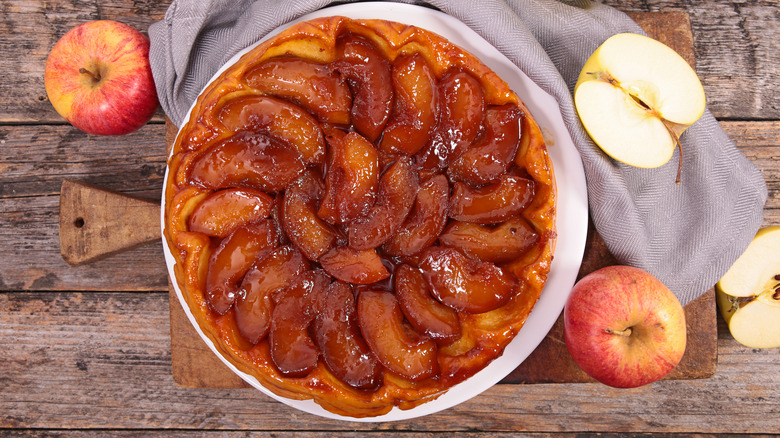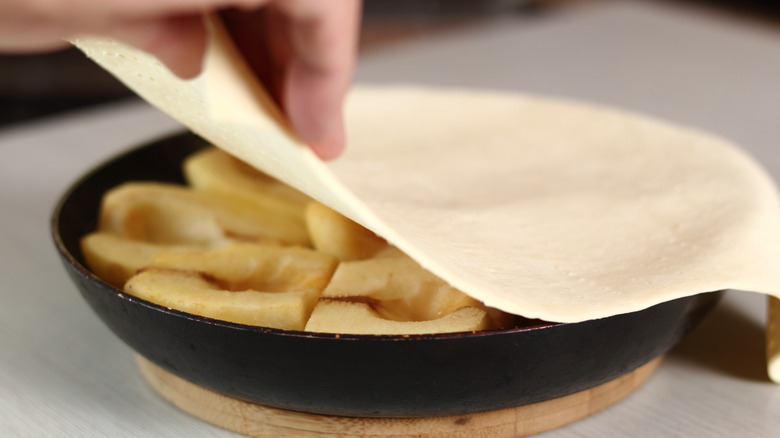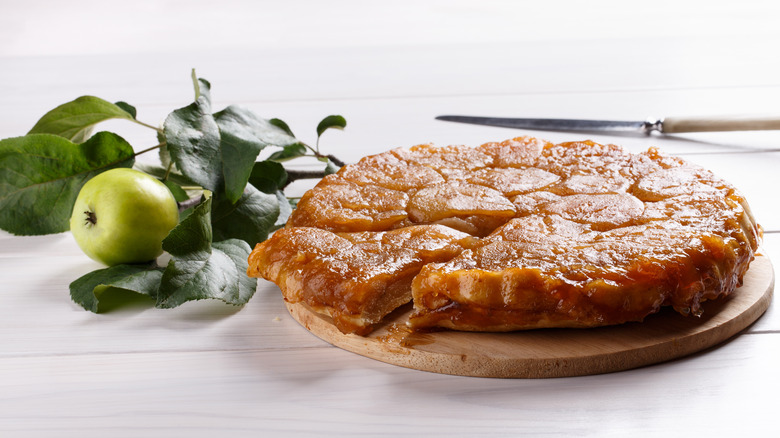The Accidental Invention Of France's Famous Tarte Tatin
We may receive a commission on purchases made from links.
Chefs are often celebrated as intellectual figures whose ambition and perfectionism drive them to create culinary masterpieces. With this glorified image in mind, it is easy for us humble home cooks to feel self-conscious about any little misstep we may make in the kitchen. In discussing the primary reasons people avoid cooking at home, The Inland Valley Daily Bulletin cited difficulty following recipes and the fear that one will "suck at the process" as chief demotivators. If you can relate to that, it may come as some comfort then to learn that many of the world's most beloved foods and beverages were created by accident, resulting from the same type of absentmindedness to which we are all susceptible at times.
Consider cornflakes, which were accidentally invented by brothers Will and John Kellogg when they were attempting to make granola. They mistakenly overcooked a batch of wheatberry, causing it to flake, and liked the results so much they repeated the process with corn (via the New York Daily News). Then there's the story of Worcestershire sauce, which came about when a pair of English pharmacists tried to recreate a sauce from India, failed, and left the results of their experiment in the cellar, forgetting the mix until it aged into a delicious new state. One case of accidental cooking genius that's less well-known in America is the tarte Tatin, a delicious treat that deserves our attention.
What is tarte Tatin?
At first glance, a tarte Tatin bears some resemblance to an upside-down cake, and there is a similar method behind it. Per MasterClass, tarte Tatin is made by tossing fruit with melted butter and sugar and cooking it all in a skillet until the mixture caramelizes. Once this is done, you place a layer of puff pastry over the top of the fruit mixture and bake it in the oven. To serve, you must flip the whole skillet upside down, so that the puff pastry becomes the base of the tarte and the caramelized fruit forms a gorgeous golden topping. Tarte Tatin is almost always made with apples, although a few variations, such as the peach tarte Tatin also exist.
The topsy-turvy cooking process accomplishes something unique that distinguishes the tarte Tatin from every other fruit tart. National Geographic explains that keeping the apples beneath the puff pastry in the oven gives the caramelized fruit an almost jam-like consistency. Meanwhile, the pastry, being fully exposed to the heat, becomes particularly crisp, unlike the bottom crust of so many pies that often turn mushy. Sometimes, shortcrust may be used in place of puff pastry which, though less traditional, is less prone to growing soggy. This show-stopping dessert is easier to make than it looks, which makes it a worthwhile endeavor, even for trepidatious home cooks.
The tarte was named after the Tatin sisters
The tarte Tatin originated at the Hôtel Tatin in the Sologne region of France, owned and operated by a pair of sisters named Caroline and Stéphanie Tatin. MasterClass explains that there are a couple of versions of the tarte Tatin's origin story, one being that Stéphanie accidentally baked an apple tart upside down and decided to serve it anyway, though this sounds a bit outlandish. Another, more plausible explanation is that Stéphanie was caramelizing apples for a more traditional pie but accidentally let them cook too long. Hoping to salvage the dish, she placed puff pastry over the well-done apples, which could conceivably protect them from further burning in the oven, and baked it just like that.
As with many such origin stories, this legend is disputed, and it's possible that Stéphanie didn't invent the dish at all. There is a similar dish called the tarte solognote which comes from the very same regions, and National Geographic adds that the concept of a "gâteau renversé" (upside-down cake) long precedes the Tatin sisters. In any event, though, the Tatins deserve credit for popularizing tarte Tatin, as evidenced by early 1900s records linking the dish to their hotel and claiming it to be a famous feature of Sologne's cuisine. The Hôtel Tatin is still in operation today, its reputation firmly built upon the tale of its founder's error.


